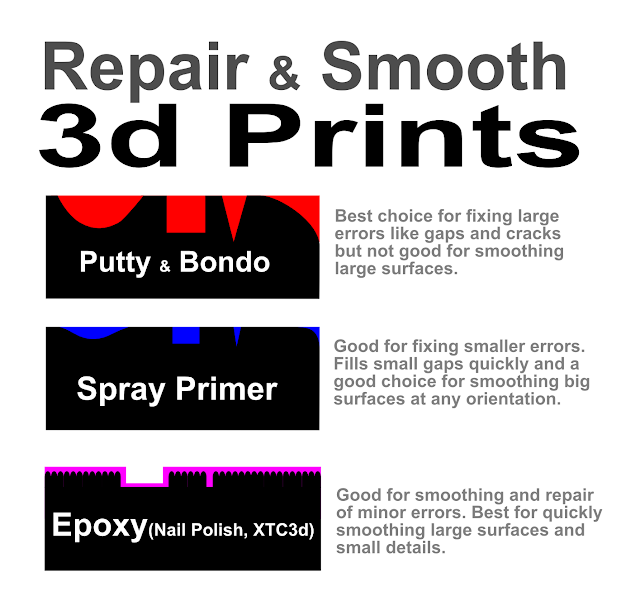I am learning how to smooth and finish 3d prints so I can cast molds from them. With single use prints I never needed to do more than a light sanding and maybe some paint. But when you start making expensive silicone molds from them, and then making multiple copies, well you want the printed object to look good. Having a hundred copies of a defective print isn't cool.
I did a lot of research and got lots of conflicting advice about what is the best way to finish prints. So I tried a lot of different materials and came to my own conclusions. I decided there is no one best solution, and I need to use the appropriate tool for the job. Jeesh, I should have known that to begin with. I use different hammers and saws for jewelry, carpentry and demolition - why would post processing 3d prints be any different?
Most of my prints are in PLA. So I do a lot of sanding - a LOT of sanding - then more sanding. Unfortunately, the sanding process removes so much material it also changes the dimensions and contours of the object. So now I'm learning to put back material after I sand.
In fact, all of these materials seem to actually increase, not decrease, the amount of sanding I do.
I still don't know much about the finishing process, but I wanted to post a little about my current preferences in materials. I think of these materials as falling into three categories: Putty, Primer and Paint. Each has its advantages and disadvantages, and I'm starting to use more than one material on a print to get the results I want.
PUTTY: I call it putty if it is so thick that I have to spread with a trowel. Anything that sticks to PLA, does not shrink when it dries and is sandable to a smooth finish is okay for me. Bondo, epoxy putty, spackle, wood putty all seem to work. I mostly use putty to fill in large gaps, joints or depressions. I do not use it for smoothing large surfaces. It is also good for making detailed creases, folds and sharp edges. If you have lost the sharp corner due to sanding, putty can help get it back.
PRIMER: I mostly use spray primer. Regular, sandable auto-body primer is fine. It covers large areas quickly and can be sanded to a smooth finish. It can cover medium sized gaps and cracks. But it tends to float on top of small cracks, not sink into them. You can hide print lines quickly, but it does change the dimensions slightly. This is my favorite for large surfaces.
PAINT: On really good prints I can paint-sand-paint a good finish quickly. Auto body spray paint works well. However, I also use nail polish as paint, especially in highly detailed areas. And the XTC 3d product works very well. Even when I use putty or primer as the first coat, I often finish the print with a final coat of paint.
No matter what you use there will still be a lot of sanding involved. And the techniques I use to make a master cast for molding might not be durable enough for something like a toy or case. But that's really why I'm starting to learn how to cast copies - durability and quick production.
I will post more about each of these materials as I learn how to use them better. I just wanted to post this to let people know you can use more than one material, there is not one perfect works-for-everything solution. Also, you can combine materials on the same project.
Right now, I'm experimenting with thinning nail polish and epoxies for "self leveling pours." I'm starting to get good results, and if I get it to work consistently I will definitely post about that.
